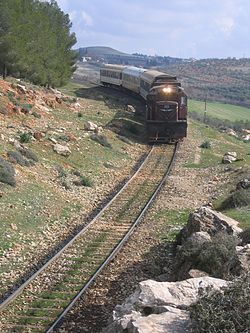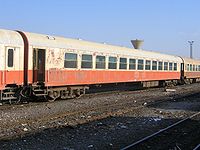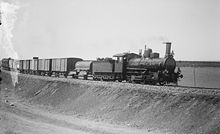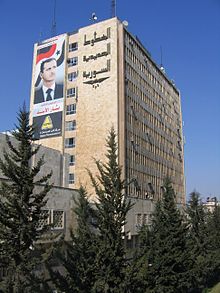- Chemins de Fer Syriens
-
Chemins de Fer Syriens 
Modern CFS passenger train, hauled by General Electric Class U17C, north of Aleppo on the former Baghdad RailwayLocale Syria Dates of operation January 1, 1965–present Predecessor Damas, Hamah et Prolongements
Hejaz railwayTrack gauge 1,435 mm (4 ft 8 1⁄2 in) Length 2,423 km Headquarters Aleppo Website http://www.cfssyria.org Chemins de Fer Syriens (English: Syrian Railways) is the national railway operator for the state of Syria, headquartered in Aleppo.[1]
Contents
History
The first railway in Syria opened when the country was part of the Ottoman Empire, with the 1,050 mm (3 ft 5 1⁄3 in) gauge line from Damascus to the port city of Beirut in present day Lebanon opened in 1895. The famous Hejaz railway opened in 1908 between Damascus and Medina in present day Saudi Arabia also used 1,050 mm gauge. Railways after this point were built to 1,435 mm (4 ft 8 1⁄2 in), including the Baghdad Railway.[2] The French wanted an extension of the standard gauge railway into Libya to connect with the Palestine Railways and so agreed the building of a branch line to Tripoli, Lebanon, operated by Société Ottomane du Chemin de fer Damas-Hama et prolongements, also known as DHP.[3]
The Baghdad Railway had progressed as far as Aleppo by 1912, with the branch to Tripoli complete, by the start of World War I; and onwards to Nusaybin by October 1918. The Turks, who sided with Germany and the Central Powers, decided to recover the infrastructure south of Aleppo to the Lebanon in 1917. The Baghdad Railway created opportunity and problems for both sides, being unfinished but running just south of the then defined Syrian/Turkish border.[3]
Post war, the border was redrawn, and the railway was now north of the border. DHP reinstated the Triopli line by 1921. From 1922 the Baghdad Railway was worked in succession by two French companies, who were liquidated in 1933 when the border was again redrawn, placing the Baghdad Railway section again in Syrian control. Lignes Syriennes de Baghdad (LSB) took over operations, a subsidiary of DHP.[3]
The next big developments in Syrian railways were due to the political manoeuvering leading up to and during World War II. As Turkey had sided with Germany in World War One, the Allies were concerned with poor transport in the area, and their ability to bring force on the Turks. Having built railways extensions in both the Eastern and Western deserts of Egypt, they initially operated services via the Hejaz Railway, but were frustrated by the need to transload goods due to the gauge break. They surveyed a route from Haifa to Rayak in 1941, but decided there were too many construction difficulties. The standard gauge line from Beirut to Haifa was eventually built by Commonwealth military engineers from South Africa and Oceania during WWII, in part supplied by a 1,050 mm gauge railway to access materials.[3] Eventually Turkey remained neutral and refused the Allies access to their jointly-controlled sections of the Baghdad Railway, although by then the Allies had driven the Palestine Railway through to Al Akkari, Homs, Hama and onward to connect with the Baghdad Railway at Aleppo.[3]
Locomotives servicing the Allied war effort included the British R.A. Riddles designed WD Austerity 2-10-0, four of which post war went in to Syrian service, designed CFS Class 150.6.[4][5]
In 1956, all railways in Syria were nationalised, and reorganised as CF Syriennes (CFS) from 1 January 1965. Expanded with monetary and industrial assistance from the USSR, the agreement covered the joint industrial development of the country. Covering the development of the ports of Tartus and Latakia, they were initially connected by rail to Al Akkari and Aleppo in 1968 and 1975 respectively. An irrigation project on the Euphrates, resulting in the construction of the Tabqa Dam, drove the connection of Aleppo to Al-Thawrah (1968), Ar-Raqqah (1972) Deir ez Zor (1973), reaching the old Baghdad Railway at Al Qamishli in 1976.[3]
Today
Chemins de Fer Syriens Legend








North to Ankara (old Baghdad Railway) 








North to Nusaybin 








0.0 Border with Turkey 









Maydan Ikbis 








Al Qamishli 








Aleppo 








Euphrates river crossing 








Ar-Raqqah 








Deir ez-Zor 








Deir ez-Zor freight depot 








Ansari 








El Yarubieh (old Baghdad Railway) 








Abu Kemal 








0.0 Border with Iraq 









East to Mosul 








Latakia 








Hamah 








Tartus 








Homs 








Al Akkari 








Homs freight depot 

















0.0 Border with Lebanon 









South to Beiruit and Tripoli 








Palmyra freight only, for phosphate 

















Damascus Kadam 








0.0 Damascus al-Hijaz 

















Qatana 








Sheikh Miskin 








Zeizoun 








Dera'a 








Suwayda (proposed) 








Suwayda 








0.0 Border with Jordan 









South to Amman Today, all 1,435 mm (4 ft 8 1⁄2 in) network and trains are operated by CfS. Using all diesel-electric powered traction, the main routes are:[1][6]
- Damascus - Homs - Hamah - Aleppo - Maydan Ikbis (- Ankara TCDD)
- Aleppo - Latakia - Tartus - Al Akkari - Homs
- Homs - Palmyra: freight only, opened for phosphates traffic, destined for the port of Tartus, in 1980
- Line runs from the oilfields of Al Qamishli in the north to the port of Latakia (750 km)
- Al Akkari (- Tripoli CEL, out of use)
- Aleppo - Deir ez-Zor - Al-Qamishli (- Nusaybin TCDD)
- Extension from Homs southwards to Damascus (194 km) was opened in 1983
- 80 km (50 mi) Tartus-Latakia line in 1992
- Al Qamishli - El Yarubieh (- IRR Iraq, out of use)
- Damascus - Sheikh Miskin - Dera: under construction, to replace section of Heraz railway
- Sheikh Miskin - Suwayda (under construction)
- Palmyra - Deir ez-Zor - Abu Kemal (- IRR Iraq) (planned)
Operations
The network is operated using wholly diesel-electric traction. For operational purposes CFS is divided into three regions: Central, Eastern and Northern. At the end of 2004 CFS employed around 12,400 staff.
The railway operates well, but as it is maintained at a low level, the top speed is limited. On a 30 km (19 mi) section of the Damascus - Aleppo, speeds reach 120 km/h (75 mph), but most of the track has a limit of 110 km/h (68 mph). Most tracks of the CFS are limited to 80 km/h (50 mph). Operational train speed is also limited by a lack of interlocked signalling, with most of the system operating on a token based system. At present, Damascus's al-Hijaz railway station, which lies in the city centre, is closed, and the railway connections with other cities take place in the suburb station of Kadam.
The result is that most passenger traffic has moved to air-conditioned coaches, and the freight traffic dominates the operational trackage. The 2005 introduction of South Korean-built DMUs, where drivers were trained using a simulator,[7] on the Damascus - Aleppo route, and the high traffic Aleppo - Latakia route where intermediate stations are bypassed, have created a high usage and occupancy levels.
The only international connection is presently with Turkey. The link with Iraq, severed in the war of 2003, was restored for a time but subsequently closed again; it is scheduled to reopen in June 2009.[8] In 2008 it was proposed to open a joint rolling stock factory with Turkish State Railways at Aleppo[9]
The only remaining section of narrow gauge line, running from a point on the outskirts of Damascus into Jordan, is operated by Jordan Hejaz Railways.
Trackage
- total: 2,750 km (1,710 mi)
- standard gauge: 2,423 km (1,506 mi) 1,435 mm (4 ft 8 1⁄2 in) gauge
- narrow gauge: 327 km (203 mi) 1,050 mm (3 ft 5 1⁄3 in) gauge (2000)
Railway links with adjacent countries
On 22 April 2005, Syria ratified the Agreement on International Railways in the Arab Mashriq, which provides for the implementation of a variety of north-south and east-west links between the states of the region, including the restoration of direct rail links between Syria, Lebanon and Iraq.
 Iraq - severed 2003, at Nurabiya/Rabiya, 1,435 mm (4 ft 8 1⁄2 in). Due to recommence operations, June 2009.[8]
Iraq - severed 2003, at Nurabiya/Rabiya, 1,435 mm (4 ft 8 1⁄2 in). Due to recommence operations, June 2009.[8] Israel - defunct (narrow gauge)
Israel - defunct (narrow gauge) Jordan - yes, presently 1,050 mm (3 ft 5 1⁄3 in) gauge. In 2005, work commenced to build a 1,435 mm (4 ft 8 1⁄2 in) line.[8]
Jordan - yes, presently 1,050 mm (3 ft 5 1⁄3 in) gauge. In 2005, work commenced to build a 1,435 mm (4 ft 8 1⁄2 in) line.[8] Lebanon - defunct (standard and narrow gauge), closed mid-1970s
Lebanon - defunct (standard and narrow gauge), closed mid-1970s Turkey - yes, at Maydan Ikbis/Islahiye & Ar Ra`i/Çobanbey & Qamishli/Nusaybin & Nusaybin/Karkamis 1,435 mm (4 ft 8 1⁄2 in)[10]
Turkey - yes, at Maydan Ikbis/Islahiye & Ar Ra`i/Çobanbey & Qamishli/Nusaybin & Nusaybin/Karkamis 1,435 mm (4 ft 8 1⁄2 in)[10]
Railway vehicles
Motive power
The motive power in 2007 was noted as:[11]
Class Picture Axle Formula Number Year in Service Power [kW] Tractive Effort [kN] Max.Speed [km/h] Traction Type Voltage 1st class 2nd class Notes LDE-650 Bo-Bo 9 1968 478 DE Diesel Shunting locomotives built in France LDE-1200 Co-Co 11 1973 883 346 100 DE Diesel TEM2 Shunting locomotives built in Russia LDE-1500 CO-CO 25 1982 1102 DE Diesel Czech, similar to CD(CZ) Class 770 LDE-1800 
CO-CO 26 1976 1323 DE Diesel American built General Electric U17C export model. 30 originally built in 2 batches LDE-2800 
CO-CO 77 1982 2058 100 DE Diesel Russian TE114, 110 originally built. Partly modernised by General Electric in 2000 by fitting 12cyclinder GE FDL of 3000 hp[12] LDE-3200 
BO-BO 30 1999 3,200 hp (2,400 kW)[13] 120 DE Diesel Alstom DE32CAC diesel locomotives, engines by Ruston.[14] DMU-5 
10 2006 1680 120/160 DH Diesel 222 61 New from Hyundai Rotem, Korea for Aleppo-Damascus/Latakia long-distance services Rolling stock
 Former Deutsche Reichsbahn of German Democratic Republic OSShD-Y passenger carriage, in use now by CFS
Former Deutsche Reichsbahn of German Democratic Republic OSShD-Y passenger carriage, in use now by CFS
The railway possessed:[11]
- Passenger carriages: almost all OSShD-Y obtained mainly from the former Deutsche Reichsbahn of German Democratic Republic, the newest of which were obtained from Căile Ferate Române of Romania and Polish State Railways. The stock of 483 carriages includes: 19 restaurant, 45 sleepers and 33 baggage vans. In 2001, Iranian company Wagon Pars refurbished some stock which is still in use, while the remaining unused stock lie rotting in sidings.
- Goods wagons: freight trains are organised into block workings, covering shipments of: oil, natural gas, phosphates, grain, cement, containers, construction materials and other transports. Most of 4319 vehicles were built between 1960–1975, with the most modern stock the grain wagons imported from Iran in the early 1990s. Approximate figures for stock:
- 1294 Heavy Flat wagons
- 846 Open wagons
- 818 Oil tankers
- 762 Covered wagons
- 597 Grain wagons
- 323 Phosphate wagons
- 178 Sliding wall wagons
- 146 Self unloading wagons
- 53 Flat wagons
- 50 Natural gas tankers
- 45 Cement wagons
- 20 Water tankers
- 19 Tippers
Future
Modernisation of the Syrian rail network has been identified as a priority by the government. In 2003 it planned to invest EUR9 billion in the system, with EUR12 billion annually to be spent in succeeding years. The longer term development of the network up to 2020 has been the subject of studies undertaken with the help of the Japanese consultancy, Jaika. Proposals include the construction of new lines for speeds of up to 250 km/h to Iraq, Lebanon, Jordan and Turkey. Restructuring of CFS is foreseen, with the state assuming responsibility for infrastructure and railway operations placed in the hands of separate independent business units.[6]
Rail studies
In October 2010, CFS announced plans to set up a joint centre for rail studies, with Ferrovie dello Stato; and plans to build a rail link between Damascus and Jordan had been revived, subject to funding.[15]
See also
- Transport in Syria
- Arab Mashreq International Railway
References
- ^ a b "Chemins de fer Syriens". Ferenc Valoczy. http://members.tripod.com/~tuonela/syria/syria.html. Retrieved 2009-05-03.
- ^ http://www.sinfin.net/railways/world/syria.html
- ^ a b c d e f Hugh Hughes. "Middle East Railways". almashriq.hiof.no. http://almashriq.hiof.no/lebanon/300/380/385/railways/resources/middleeast/. Retrieved 2009-05-05.
- ^ Rowledge, J.W.P. (1987). Austerity 2-8-0s & 2-10-0s.. London: Ian Allan.
- ^ "CFS Motive Power". http://almashriq.hiof.no/lebanon/300/380/385/railways/stock/. Retrieved 2009-05-04.
- ^ a b "Chemins de fer Syriens". Jaynes. http://www.janes.com/extracts/extract/jwr/jwr_0567.html. Retrieved 2009-05-03.[dead link]
- ^ "Syrian train simulator". YouTube. April 15, 2008. http://www.youtube.com/watch?v=zX4rGm6EnKg. Retrieved May 7, 2009.
- ^ a b c "June launch scheduled for Iraq-Syria railway". arabiansupplychain.com. April 29, 2009. http://arabiansupplychain.com/article-2119-june_launch_scheduled_for_iraq_syria_railway/. Retrieved May 3, 2009.
- ^ http://railwaysafrica.com/index.php?option=com_content&task=view&id=3554&Itemid=37
- ^ Arab Turkish Travel Gazette:Third railway gate between Turkey-Syria opens, December 26, 2009
- ^ a b "CFS". railfaneurope.net. 2007-06-25. http://www.railfaneurope.net/list/syria/syria_cfs.html. Retrieved 2007-05-03.
- ^ "GE Locomotives in Asia & Middle East". locopage.net. http://www.locopage.net/asia-pics.htm. Retrieved 2009-05-04.
- ^ European traction locomotive[dead link]
- ^ Railfaneurope.net : Syrian diesels
- ^ "SYRIA". http://www.railwaysafrica.com/blog/2010/11/syria/. Retrieved 2010-11-09.
External links
Rail transport in Asia Sovereign
states- Afghanistan
- Armenia
- Azerbaijan
- Bahrain
- Bangladesh
- Bhutan
- Brunei
- Burma (Myanmar)
- Cambodia
- People's Republic of China
- Cyprus
- East Timor (Timor-Leste)
- Egypt
- Georgia
- India
- Indonesia
- Iran
- Iraq
- Israel
- Japan
- Jordan
- Kazakhstan
- North Korea
- South Korea
- Kuwait
- Kyrgyzstan
- Laos
- Lebanon
- Malaysia
- Maldives
- Mongolia
- Nepal
- Oman
- Pakistan
- Philippines
- Qatar
- Russia
- Saudi Arabia
- Singapore
- Sri Lanka
- Syria
- Tajikistan
- Thailand
- Turkey
- Turkmenistan
- United Arab Emirates
- Uzbekistan
- Vietnam
- Yemen
States with limited
recognition- Abkhazia
- Nagorno-Karabakh
- Northern Cyprus
- Palestine
- Republic of China (Taiwan)
- South Ossetia
Dependencies and
other territories- Christmas Island
- Cocos (Keeling) Islands
- Hong Kong
- Macau
Categories:- Rail transport in Syria
- Railway companies of Syria
- Government-owned companies in Syria
- Aleppo
- Standard gauge railways in Syria
Wikimedia Foundation. 2010.






